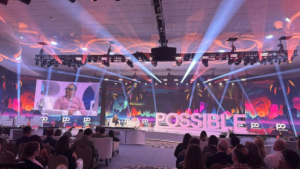Dan Jones, Cavai UK’s Commercial Director, discusses the growing significance of mid-funnel marketing, and how mid-funnel problems can be solved with conversational advertising.
At its core, the marketing funnel is an abstract concept, a mechanism invented to make sense of the complex, theoretical path all consumers travel, from initial awareness of a product/service to the very real action of a hard cash conversion. Like most abstract elements, at times the marketing funnel’s subtleties can be hard to pin down. It is in a constant state of flow and flux as audience behaviour and technological advancement expand and reduce the significance of the three main sections: awareness at the top, consideration in the middle, and conversion at the bottom.
It is the mid-funnel that we are interested in here, because it is becoming critical for those looking to both increase the reach of their marketing efforts while engaging in deeper, more meaningful conversations with their audience. And, because of this, it is also the place advertisers are given the opportunity to change consumers’ minds.
The mid-funnel is where discovery, education and qualification of a consumer’s needs takes place. It is the juicy middle of the funnel that connects the awareness and conversion sections, and it’s where brands get to spend the most time with their consumers via long-dwell ad formats. Advances in technology mean the mid-funnel is the best place to replicate real-world, offline interactions between consumers, brands and their ambassadors to create curated, personalised shopping experiences. Provide a value exchange, and consumers will react positively.
These same advances are making new types of conversational interactions more affordable for brands to take part in. The creative opportunities are also there to produce high-impact, engaging, emotional rich-media ads, and other solutions just can’t replicate either the cost efficiency or effectiveness of these campaigns and formats.
Online is the place to get the most out of mid-funnel activity. It offers a deeper, more engaging mode of communication at the consumer’s critical moment of decision – the time between becoming aware of a product and deciding to buy it.
The surprise in all this is just how slow brands – of all shapes and sizes – have been in realising the significant opportunities mid-funnel has to offer. Over-spend at the top and bottom of the funnel has also been a problem for some time. This is where immediate, attractive metrics such as conversions and brand awareness are easy to measure and celebrate. However, this is beginning to change. Last year, for instance, Adidas pledged to invest more heavily in the mid-funnel. The idea is to push understanding and the values of the Adidas brand and create high-impact moments of emotional engagement with its audience for lasting depth and desirability. That doesn’t mean a reduction of spend at the top and bottom of the funnel, but inflated mid-funnel spend will gain efficiencies because it can change a consumer’s mind and influence a purchase.
In many ways, conversational advertising reflects the pinnacle of mid-funnel opportunity. It has the ability to solve any mid-funnel issue a brand is likely to encounter. Conversational allows brands to engage with their customers by providing tailored value and offering deep experiences. This again allows brands to impart brand and product information and change consumers’ minds, which can ultimately influence their purchasing decisions. In this way, the success of a mid-funnel campaign shouldn’t be judged simply on the fact that it’s where brands spend the most time with customers, but rather on solid outcomes. There’s no doubt that conversational blurs the boundaries between mid- and lower-funnel actions, because it has the ability, in some instances, to place an item in a consumer’s basket, ready for checkout.
Conversational advertising is proving to be so successful because it synthesises the offline trust formed between a brand and consumer when they interact in the real world to form a relationship, wherever that then leads. Conversational solutions ask a customer questions and enable them to discover a product or service in their own time, on their own terms – a rare thing in digital advertising.






